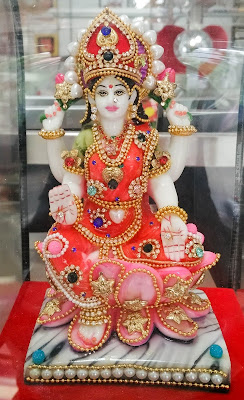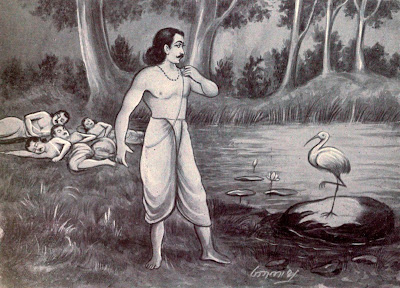Reading Notes: The Ten Incarnations of Lord Vishnu
After diving into the story of Vishnu's incarnation as Rama, I was curious about the other forms that Vishnu has taken on earth and what the stories were behind each of these incarnations. This comic provided a sort of "cliff notes" version of each one, introducing the major plot points and the most important characters and their interactions.
Favorite Incarnation
In his incarnation as Varaha, Vishnu takes on the form of a boar. He dives into the ocean and begins digging Bhoomdevi, the Earth Mother, out of the ocean bed where she is trapped. Despite a menacing foe that appears to slay the boar as he is performing his task, the boar succeeds in bringing Bhoomdevi to the surface. She may then provide the land where the first man and woman will begin the human race. I found it very amusing that the boar was able to vanquish the mighty asura with nothing more than a "[playful] hit" behind the ears.
Biblical References
There were elements of several of these tales that reminded me of biblical stories. In the story of the Varaha Avatar, Swayambhuva Manu and Shatarupa are introduced as the first man and woman destined to have children and propagate the human race on earth. In the story of the Matsya Avatar, Sage Satyavrata is instructed by Vishnu, who has taken on the form of a giant fish, to gather the Sapta Rishis and the animals, herbs, and seeds that he wishes to take into the next kalpa.
It continues to fascinate me to observe elements that appear in both the stories of Western and Eastern traditions; this overlap reveals the power of our shared humanity. Across time and space, we are observing our world in similar ways, and are telling similar stories. Given that I am planning to base my storybook project on mashups of the Bible and the Indian Epics, seeing these references allows me to gather ideas for how to combine these traditions.
Bibliography
Favorite Incarnation
In his incarnation as Varaha, Vishnu takes on the form of a boar. He dives into the ocean and begins digging Bhoomdevi, the Earth Mother, out of the ocean bed where she is trapped. Despite a menacing foe that appears to slay the boar as he is performing his task, the boar succeeds in bringing Bhoomdevi to the surface. She may then provide the land where the first man and woman will begin the human race. I found it very amusing that the boar was able to vanquish the mighty asura with nothing more than a "[playful] hit" behind the ears.
Biblical References
There were elements of several of these tales that reminded me of biblical stories. In the story of the Varaha Avatar, Swayambhuva Manu and Shatarupa are introduced as the first man and woman destined to have children and propagate the human race on earth. In the story of the Matsya Avatar, Sage Satyavrata is instructed by Vishnu, who has taken on the form of a giant fish, to gather the Sapta Rishis and the animals, herbs, and seeds that he wishes to take into the next kalpa.
It continues to fascinate me to observe elements that appear in both the stories of Western and Eastern traditions; this overlap reveals the power of our shared humanity. Across time and space, we are observing our world in similar ways, and are telling similar stories. Given that I am planning to base my storybook project on mashups of the Bible and the Indian Epics, seeing these references allows me to gather ideas for how to combine these traditions.
Vishnu in his incarnation as a boar. Source: Wikimedia Commons
~~~
Bibliography
Katha, Amar C. “The Ten Incarnations of Lord Vishnu.” Dasha
Avatar. Vol. 10002.




Comments
Post a Comment